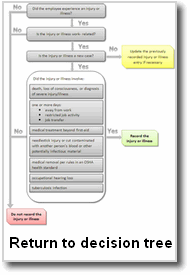Coordinators
Determination of new cases
For the purpose of determining whether an injury is OSHA recordable, you must consider an injury or illness to be a “new case” if:
- The employee has not previously experienced a recorded injury or illness of the same type that affects the same part of the body, or
- The employee previously experienced a recorded injury or illness of the same type that affected the same part of the body but had recovered completely (all signs and symptoms had disappeared) from the previous injury or illness and an event or exposure in the work environment caused the signs or symptoms to reappear.
Frequently asked questions
(1) When an employee experiences the signs or symptoms of a chronic work-related illness, do I need to consider each recurrence of signs or symptoms to be a new case?
No, for occupational illnesses where the signs or symptoms may recur or continue in the absence of an exposure in the workplace, the case must only be recorded once. Examples may include occupational cancer, asbestosis, byssinosis and silicosis.
(2) When an employee experiences the signs or symptoms of an injury or illness as a result of an event or exposure in the workplace, such as an episode of occupational asthma, must I treat the episode as a new case?
Yes, because the episode or recurrence was caused by an event or exposure in the workplace, the incident must be treated as a new case.
(3) May I rely on a physician or other licensed health care professional to determine whether a case is a new case or a recurrence of an old case?
You are not required to seek the advice of a physician or other licensed health care professional. However, if you do seek such advice, you must follow the physician or other licensed health care professional’s recommendation about whether the case is a new case or a recurrence. If you receive recommendations from two or more physicians or other licensed health care professionals, you must make a decision as to which recommendation is the most authoritative (best documented, best reasoned, or most authoritative), and record the case based upon that recommendation.
(4) How can I determine whether an employee has “recovered completely” from a previous injury or illness such that a later injury or illness of the same type affecting the same part of the body resulting from an event or exposure at work is a “new case” ?
An employee has “recovered completely” from a previous injury or illness when he or she is fully healed or cured. The employer must use his best judgment based on factors such as the passage of time since the symptoms last occurred and the physical appearance of the affected part of the body. If the signs and symptoms of a previous injury disappear for a day only to reappear the following day, that is strong evidence the injury has not properly healed.
The employer may, but is not required to, consult a physician or other licensed health care provider (PLHCP). Where the employer does consult a PLHCP to determine whether an employee has recovered completely from a prior injury or illness, it must follow the PLHCP’s recommendation. In the event the employer receives recommendations from two or more PLHCPs, the employer may decide which recommendation is the most authoritative and record the case based on that recommendation.


